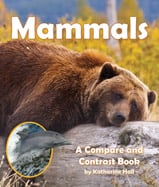Alignment to Standards for MO

| Grade | Number | Standard |
|---|---|---|
| 1 | SC-LO 1D1b. | physical structures of a variety of animals (e.g., sensory organs, beaks, appendages, body covering) |
| 1 | SC-LO 1D1d. | Identify the relationships between the physical structures of animals and the function of those structures (e.g., taking in water, support, movement, obtaining food, reproduction |
| 1 | SC-LO 1D5a. | Compare structures (e.g., wings vs. fins vs. legs; gills vs. lungs; feathers vs. hair vs. scales) that serve similar functions for animals belonging to different vertebrate classes |
| 1 | SC-LO 1DKa. | Observe and compare the structures and behaviors of different kinds of plants and animals |
| 1 | SC-LO 1E5a. | Explain how similarities are the basis for classification |
| 1 | SC-LO 1E5c. | Classify animals as vertebrates or invertebrates |
| 1 | SC-LO 1E5d. | Classify vertebrate animals into classes (amphibians, birds, reptiles, mammals, fish) based on their characteristics |
| 1 | SC-LO 1E5e | Identify plants or animals using simple dichotomous keys |
| 3 | SC-EC 3C4b. | Identify specialized structures and senses and describe how they help animals survive in their environment (e.g., antennae, body covering, teeth, beaks, whiskers, appendages |
| 3 | SC-EC 3C4c. | internal cues (e.g., hunger) and external cues (e.g., changes in the environment) that cause organisms to behave in certain ways (e.g., hunting, migration, hibernation |
| 3 | SC-EC 3C4d. | Predict which plant or animal will be able to survive in a specific environment based on its special structures or behaviors. |